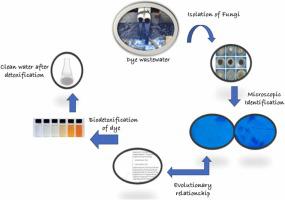当前位置:
X-MOL 学术
›
Environ. Technol. Innov.
›
论文详情
Our official English website, www.x-mol.net, welcomes your feedback! (Note: you will need to create a separate account there.)
Exploring indigenous fungal isolates for efficient dye degradation: A comprehensive study on sustainable bioremediation in the total environment
Environmental Technology & Innovation ( IF 7.1 ) Pub Date : 2024-03-28 , DOI: 10.1016/j.eti.2024.103615 Abrar Hussain Mian , Sadia Qayyum , Samia Zeb , Tehreem Fatima , Kashmala Jameel , Bushra Rehman
Environmental Technology & Innovation ( IF 7.1 ) Pub Date : 2024-03-28 , DOI: 10.1016/j.eti.2024.103615 Abrar Hussain Mian , Sadia Qayyum , Samia Zeb , Tehreem Fatima , Kashmala Jameel , Bushra Rehman

|
Synthetic dyes used in textile industries are hazardous and toxic to the environment, as some of the dyes used in these industries are non-biodegradable. Sustainable technologies using microbes are an eco-friendly and economical approach. Fungal decolorization processes are gaining much importance as biomass absorbs enzymes used in biodegradation. In the current study, six samples of dye wastewater were collected from different industries in the Faisalabad industrial area in Pakistan. The physiological characteristics of these samples were analyzed, and various parameters, including pH, temperature, BOD, COD, and electric conductivity, were investigated. Among six different (sample A-F) wastewater samples, the maximum reduction in BOD was observed in sample E, i.e.,1.3.In contrast, the maximum reduction in COD of sample C, i.e., 30, was observed. These samples' hydrogen ion concentration (pH) was mainly in an alkaline ratio, and a maximum electric conductivity of 8810 µS/cm of sample A was observed. In contrast, a minimum sample E (540 mg/L) was observed. Three indigenous fungal strains were screened and purified from dye wastewater for detoxification of dyes and were identified morphologically and on a molecular basis as . A comparative analysis of two methods, the tube overlay method and the liquid medium method, were conducted to biodetoxification synthetic dyes, including malachite green, methylene blue, and nigrosine. Spectrophotometric analysis showed that indigenous fungal strains, i.e., decolorizing methylene blue at about 93%, followed by decolorizing malachite green at about 80% and decolorizing about 90% of malachite green have good potential for degradation of dyes. These strains can be a potential source for treating textile dye effluent.
中文翻译:

探索本土真菌分离株以有效降解染料:整个环境中可持续生物修复的综合研究
纺织工业中使用的合成染料对环境有害且有毒,因为这些工业中使用的一些染料是不可生物降解的。使用微生物的可持续技术是一种环保且经济的方法。随着生物质吸收生物降解中使用的酶,真菌脱色过程变得越来越重要。在当前的研究中,从巴基斯坦费萨拉巴德工业区的不同行业收集了六个染料废水样品。分析了这些样品的生理特性,并研究了各种参数,包括 pH、温度、BOD、COD 和电导率。在六个不同的(样品AF)废水样品中,在样品E中观察到BOD的最大降低,即1.3。相比之下,在样品C中观察到COD的最大降低,即30。这些样品的氢离子浓度(pH)主要处于碱性比例,并且观察到样品A的最大电导率为8810μS/cm。相反,观察到最低样品 E (540 mg/L)。从染料废水中筛选和纯化了三种用于染料解毒的本土真菌菌株,并在形态学和分子基础上鉴定为 。对孔雀石绿、亚甲蓝、苯胺黑等合成染料的生物解毒作用,对管覆盖法和液体介质法两种方法进行了比较分析。分光光度分析表明,本土真菌菌株,即对亚甲基蓝脱色约93%,其次对孔雀石绿脱色约80%,对孔雀石绿脱色约90%,具有良好的染料降解潜力。这些菌株可以成为处理纺织染料废水的潜在来源。
更新日期:2024-03-28
中文翻译:

探索本土真菌分离株以有效降解染料:整个环境中可持续生物修复的综合研究
纺织工业中使用的合成染料对环境有害且有毒,因为这些工业中使用的一些染料是不可生物降解的。使用微生物的可持续技术是一种环保且经济的方法。随着生物质吸收生物降解中使用的酶,真菌脱色过程变得越来越重要。在当前的研究中,从巴基斯坦费萨拉巴德工业区的不同行业收集了六个染料废水样品。分析了这些样品的生理特性,并研究了各种参数,包括 pH、温度、BOD、COD 和电导率。在六个不同的(样品AF)废水样品中,在样品E中观察到BOD的最大降低,即1.3。相比之下,在样品C中观察到COD的最大降低,即30。这些样品的氢离子浓度(pH)主要处于碱性比例,并且观察到样品A的最大电导率为8810μS/cm。相反,观察到最低样品 E (540 mg/L)。从染料废水中筛选和纯化了三种用于染料解毒的本土真菌菌株,并在形态学和分子基础上鉴定为 。对孔雀石绿、亚甲蓝、苯胺黑等合成染料的生物解毒作用,对管覆盖法和液体介质法两种方法进行了比较分析。分光光度分析表明,本土真菌菌株,即对亚甲基蓝脱色约93%,其次对孔雀石绿脱色约80%,对孔雀石绿脱色约90%,具有良好的染料降解潜力。这些菌株可以成为处理纺织染料废水的潜在来源。



























 京公网安备 11010802027423号
京公网安备 11010802027423号